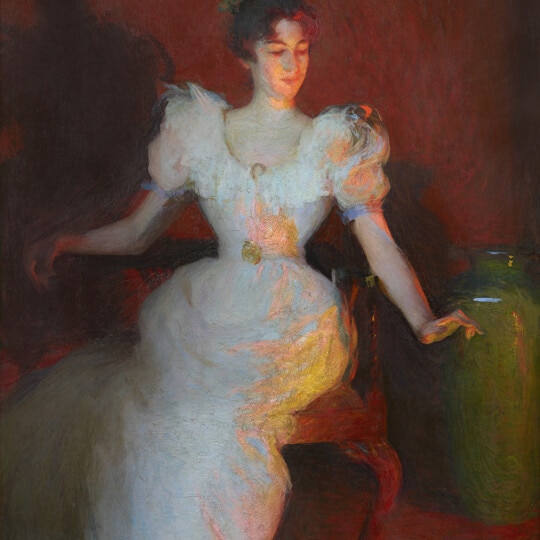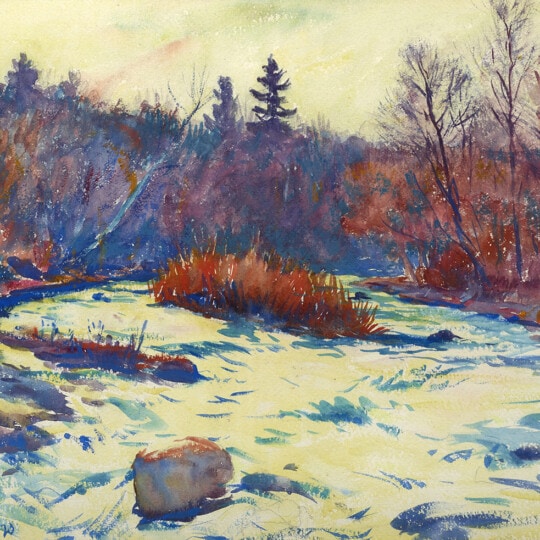Frank Weston Benson
Artist Biography
An American Impressionist and member of the Ten American Painters best known for his plein-air paintings
By Alexandra A. Jopp
Frank Weston Benson, “America’s Most Medaled Painter,” was renowned for his images of female figures on a hilltop presented with Impressionist atmospheric techniques
I. Biography
II. Chronology
III. Collections
IV. Exhibitions
V. Memberships
VI. Notes
VII. Suggested Resource
I. Biography
Frank Weston Benson was born in Salem, Massachusetts, in 1862, the second of six children of a wealthy Boston cotton merchant. With the exception of a few years spent studying abroad, he was a lifelong resident of Salem. Benson began his artistic studies in 1880 at the School of Drawing and Painting at the Museum of Fine Arts in Boston under the German professor Emil Otto Grundmann. Among his fellow students were Impressionists Robert Reid and Edmund Tarbell, who became Benson’s lifelong friends as well as fellow members of “The Ten,” a group associated with Impressionism and certain other styles, such as Tonalism. Benson would become one of the leading American artists of the second half of the nineteenth century and the first half of the twentieth, praised for his “strengths of modeling, in free, spontaneous, sympathetic sweep of brush” and for his “shimmering color and radiance of light.”1
In 1883, Benson left for a three-year stay in Paris, where he studied at the Académie Julian under Gustave Bouguereau and Jules Joseph LeFebvre. Benson spent the summer of 1884 at the seaside artists’ colony of Concarneau, Brittany, on the west coast of France, and later visited Germany, Italy, and England. Benson’s early works were of marine and rural subjects and in 1885, he exhibited his large composition After the Storm (1884; private collection) at the Royal Academy. He then returned to America, where he opened a studio in Salem. He later worked as a portraitist and teacher in Portland, Maine, for two years before taking a position in Boston, where he specialized in illustrations of upper-class women in calm, domestic settings.
In 1888, Benson married Ellen Perry Peirson, and the couple had four children: Eleanor, George, Elizabeth, and Sylvia. The following year, he was granted a teaching position at the Boston Museum. Benson’s first American showing was at the Society of American Artists in 1888. This was followed by his first major exhibition in Boston with his friend Tarbell, at the J. Eastman Chase Gallery in 1889. Benson received wide recognition for his works, including numerous awards such as the National Academy of Design’s Hallgarten Prize in 1889 for a nude titled Orpheus (private collection), the Clarke prize in 1891 for Twilight, and a medal at the 1893 World’s Columbian Exposition in Chicago.
Searching for a style of his own, Benson spent several summers in Dublin, New Hampshire, between the late 1880s and the mid-1890s. His works somewhat recalled Vermeer, Meissonier (called the “Dutch little master“), and William Merritt Chase, but in a more traditional vein. Some of Benson’s paintings from that period include My Little Girl (1885, private collection), which won third prize at the 53rd Boston Art Club exhibition in 1886.
In 1896, Benson decorated ceilings and walls in Washington, D.C.’s new Library of Congress with the murals Three Graces and The Four Seasons. The project inspired several decorative compositions of statuesque, allegorical figures. The same year, Benson won the Shaw prize from the Society of American Artists for his decorative allegory Summer (1890).
Shortly before 1900, Benson began to work outdoors often, embracing the principles of plein air painting. His first significant works from this period were Children in the Woods (1898, private collection) and The Sisters (1899, private collection). Both paintings were composed in a fluid and colorful impressionist technique, and The Sisters, which featured the artist’s two youngest daughters, Sylvia and Elizabeth, won first place at the Carnegie Institute exhibition in November 1899 and medals in Paris in 1900, Buffalo in 1901, and St. Louis in 1904. The success of these works helped Benson, who was becoming known as America’s most-medaled painter, to establish his artistic path. Over the next twenty years, Benson painted his best-known images, depicting his wife and daughters wearing white or pastel-colored dresses and often silhouetted against an azure sky. Many of his vibrant images reflect the beauty of the clear air of Maine, where he summered starting in 1901 on North Haven Island in Penobscot Bay.
Benson’s later paintings shifted to wildlife subjects, reflecting his love for nature, fishing, and hunting. In 1913, he stopped teaching and started to produce etchings, mainly of wild fowl. His first solo exhibition of etchings and drypoints in 1915 proved extremely popular. After 1919, he focused on producing watercolor landscapes, which were in great demand. Active until nearly the end of his life, he maintained a studio in Boston until 1944 and summer houses in Maine and Cape Cod before retiring to Salem, where he died on November 14, 1951.
II. Chronology
1862 Born on March 24 to George Wiggin Benson and Elizabeth Frost Poole, in Salem,
Massachusetts
1880 Began three years of study at the Museum of Fine Arts, Boston
1883 Went to Paris and studied for two years at the Academie Julian under Boulanger and
Lefebvre; summered at Concarneau in Brittany
1885 Returned to the United States and began painting in Salem
1886 Taught drawing and painting at the Portland, Maine, Society of Art
1888 Married Ellen Perry Peirson
1889 Became teacher of drawing and painting from nude figures at Museum of Fine Arts in
Boston; exhibited at National Academy of Design, New York
1893 Exhibited at World’s Columbian Exposition in Chicago; won medal
1896 Awarded Shaw Fund Prize by Society of American Artists
1898 Became founding member of the Ten American Painters
1900 Exhibited at Exposition Universelle in Paris and won silver medal; exhibited at St. Botolph
Club in Boston
1901 Exhibited at Pan-American Exposition in Buffalo and won silver medal
1904 Exhibited at Louisiana Purchase Exposition in St. Louis and won gold medal
1908 Awarded Temple Gold Medal by Pennsylvania Academy of the Fine Arts
1912 Began experimenting with etching and drypoint
1919 Awarded first W.A. Clarke prize and Corcoran Gold Medal
1920 Retrospective exhibition held at Corcoran Gallery of Art in Washington, D.C.
1941 Major retrospective of graphic works held at Guy Mayer Gallery in New York
1951 Died on November 14 in Salem
III. Collections
Addison Gallery of American Art, Andover, Massachusetts
Art Institute of Chicago
Bowdoin College Museum of Art, Maine
Brooklyn Museum
Butler Institute of American Art, Ohio
Clay Center for the Arts & Sciences, Charleston, West Virginia
Cleveland Museum of Art, Ohio
Currier Gallery of Art, New Hampshire
Detroit Institute of Arts, Michigan
Fine Arts Museums of San Francisco
Harvard University Art Museums, Massachusetts
Indianapolis Museum of Art, Indiana
Maier Museum of Art at Randolph-Macon Woman's College, Virginia
Metropolitan Museum of Art, New York
Museum of Fine Arts, Boston
National Academy Museum & School of Fine Arts, New York
National Art Museum of Sport at Indiana University, Indianapolis
National Gallery of Art, Washington D.C.
Peabody Essex Museum, Massachusetts
Pennsylvania Academy of the Fine Arts, Philadelphia
Rhode Island School of Design Museum of Art
Ruth Chandler Williamson Gallery at Scripps College, California
Smart Museum of Art at the University of Chicago
Smithsonian American Art Museum, Washington D.C.
Terra Foundation for American Art, Chicago
The Huntington Library, California
University of New Hampshire, Durham
Westmoreland Museum of American Art, Greensburg, Pennsylvania
Wichita Art Museum, Kansas
Woodson Art Museum, Wausau, Wisconsin
Worcester Art Museum, Massachusetts
IV. Exhibitions
1885, 1887, 1889, 1890–03 (prize) 1904–08 (gold), 1909–39 Pennsylvania Academy of the Fine Arts
1889 (prize), 1891 (prize), 1906 (prize) National Academy of Design
1893 (medal) Columbian Expo, Chicago
1881, 1886-88, 1890, 1892, 1894–95 (prize), 1896 (prize) Mechanics Association, Boston (medal); Cleveland Art Association; Boston Art Club
1896 (prize) SAA
1896, 1899, 1903 (gold) Carnegie Institute (medal)
1900 (medal), 1902, 1909 Paris Expo
1901 Pan-American Expo, Buffalo
1904 (two gold medals) St. Louis Expo
1906 (gold) Philadelphia Art Club
1907–57, (prize, 1907, gold, 1919) Corcoran Art Gallery
1918 Chicago SE (prize)
1909 (medal), 1912 (med., prize), 1922 (gold) Art Institute of Chicago
1912 (inaugural) Newport Art Museum
1924 (gold) Philadelphia Watercolor Society
1926 (gold medal for watercolor) Sesqui-Centennial International Exposition, Philadelphia
1988 Spanierman Gallery, New York
1991 Vose Gallery, Boston
V. Memberships
National Academician
Ten American Painters
National Institute of Arts and Letters
Chicago Society of Etchers
National Association of Portrait Painters
Guild of Boston Artists
Boston Society of Watercolor painters
Society of American Etchers
American Academy of Arts & Sciences
VI. Notes
Minna C. Smith, “The Work of Frank W. Benson.” International Studio 35 (Oct. 1908): xcix-cvi.
VII. Suggested Resources
Bedford, Faith Andrews. The Sporting Art of Frank W. Benson. Boston: David R. Godine, 2000.
Domit, Moussa. American Impressionist Painting. Washington, D.C.: National Gallery of Art, 1973.
Hiesinger, Ulrich W., Impressionism in America: The Ten American Painters. Munich: Prestel; New
York: te Neues, 1991.


